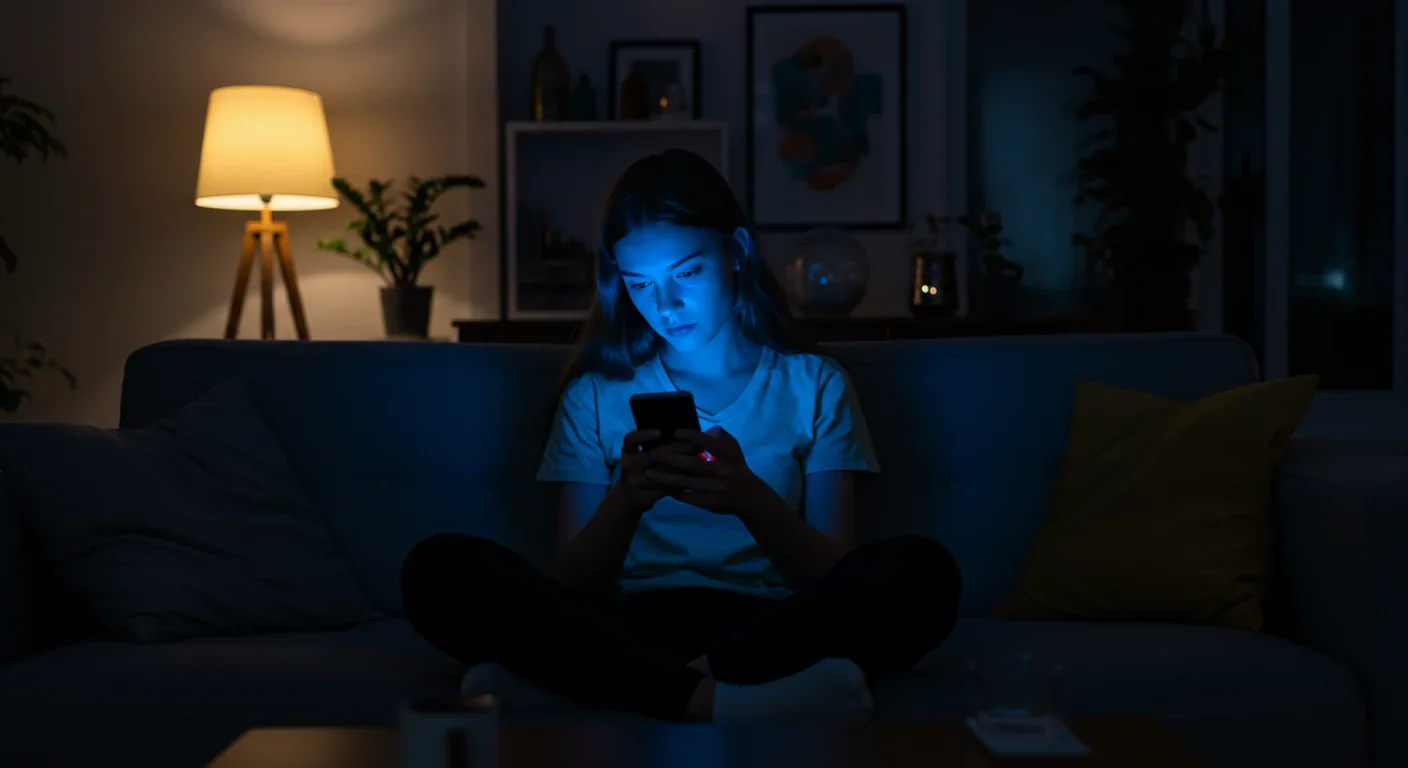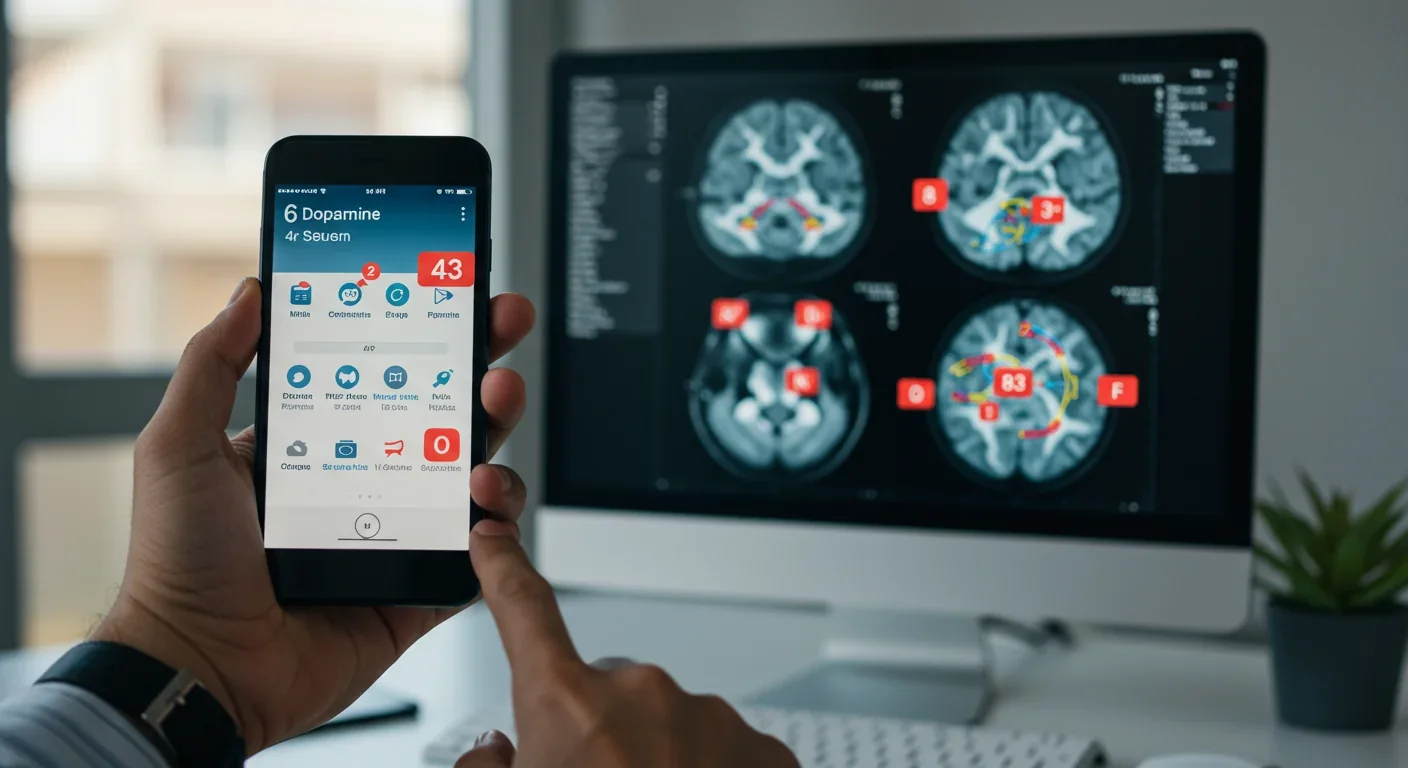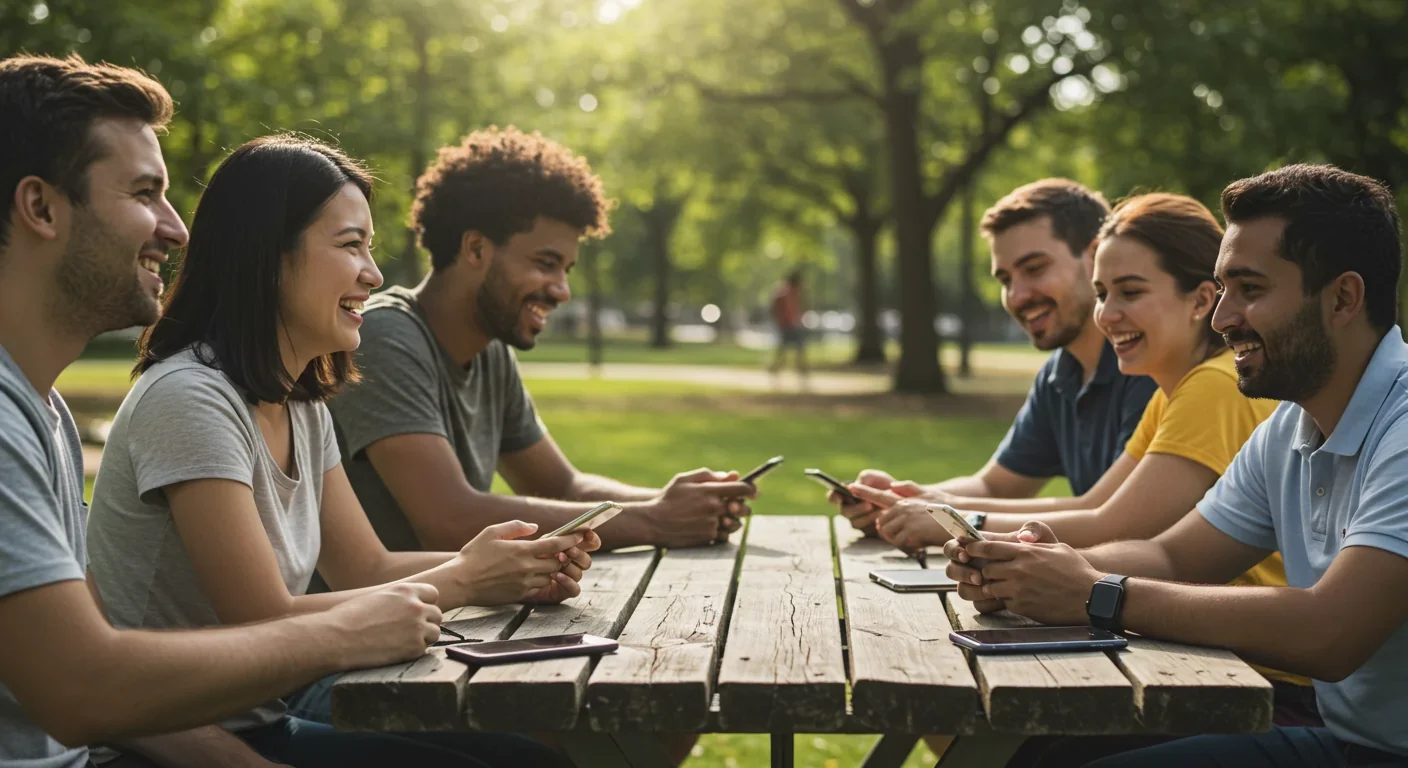Why Your Brain Sees Gods and Ghosts in Random Events

TL;DR: Social media platforms use psychological manipulation techniques—variable rewards, dopamine loops, and infinite scroll—to capture attention and form addictive habits, resulting in measurable mental health impacts, productivity loss, and political polarization that require both individual action and regulatory intervention.

Your phone buzzes. Before you consciously decide to check it, your hand is already reaching. Within seconds, you're scrolling, your pupils dilating slightly as each new post appears. Twenty minutes vanish. You look up, disoriented, wondering where the time went.
This isn't a personal failing. It's precisely what the platform was designed to make you do.
Every tap, swipe, and scroll you make feeds into systems engineered by teams of psychologists, neuroscientists, and behavioral economists. Their job? Keep you engaged. The longer you stay, the more ads you see, the more data you generate, and the more money flows into Silicon Valley. What looks like a simple app is actually a sophisticated attention-capture system built on decades of research into human vulnerability.
At the heart of most addictive platforms lies something called the Hook Model, developed by behavioral economist Nir Eyal. It's deceptively simple: Trigger → Action → Reward → Investment.
Trigger: A notification pops up. Your friend tagged you. Someone liked your post. A message awaits. These external triggers train your brain to expect something important. Over time, internal triggers develop. Boredom becomes a cue to check Instagram. Loneliness prompts you to open TikTok. The platform doesn't even need to notify you anymore because you've internalized the habit.
Action: The barrier to engagement is microscopic. One tap. One swipe. Platform designers obsess over reducing friction because every extra second of effort means potential users slip away. Infinite scroll eliminates the natural stopping point of turning a page. Auto-play ensures you never have to decide to watch the next video; it simply begins.
Reward: This is where the neuroscience gets fascinating. Social media doesn't give you predictable rewards. Instead, it uses variable ratio reinforcement, the same mechanism that makes slot machines so addictive. Sometimes your post gets two likes. Sometimes it gets two hundred. You never know, so your brain stays in a heightened state of anticipation.
B.F. Skinner discovered this in the 1950s when he found that rats would press a lever far more frantically when rewards came at unpredictable intervals. Humans aren't different. That unpredictability triggers dopamine spikes not when you receive the reward, but in anticipation of it. Your brain chemistry literally changes to keep you checking.
Investment: The final phase locks you in. Every photo you upload, every connection you make, every comment you leave increases what psychologists call "stored value." You're not just using the platform anymore. You're building something there, which makes leaving feel like abandoning a part of yourself.
When you scroll through your feed, your brain isn't passively observing. It's being rewired.
The prefrontal cortex, responsible for rational decision-making and impulse control, shows reduced activity during compulsive social media use. Meanwhile, the nucleus accumbens, your brain's reward center, lights up like Times Square. This same pattern appears in studies of gambling addiction and substance abuse.
Dopamine plays the starring role. Often misunderstood as a "pleasure chemical," dopamine is actually about motivation and anticipation. It drives you to seek rewards, not enjoy them. Social media exploits this by creating what researchers call dopamine loops. Each notification promises a potential reward. Each scroll might reveal something interesting. Your brain learns that engagement equals dopamine, so it pushes you to engage more.
The impact compounds over time. Heavy social media users show structural changes in brain regions associated with attention, memory, and emotional regulation. The amygdala, which processes fear and threat, becomes hyperactive. Your brain starts treating social exclusion, unflattering comparisons, and negative content as genuine threats to survival.

The statistics are sobering. Among adolescents who engage in excessive scrolling, 45% develop psychiatric symptoms within nine months. Adults spending over two hours daily on negative content show four times higher rates of depression and double the anxiety levels compared to moderate users.
The mechanism is multifaceted. Social comparison theory, identified decades before social media existed, explains that we evaluate ourselves based on comparisons with others. Platforms supercharge this by showing us carefully curated highlight reels of everyone else's lives. Research shows that upward social comparison—measuring yourself against people who seem more successful—directly correlates with lowered self-esteem and depressive symptoms.
Instagram and TikTok amplify this through visual content. A 2024 systematic review found that exposure to idealized influencer content significantly worsens body image and mood, especially among teenagers. Harvard professor S. Bryn Austin, an eating disorders expert, stated that image-based platforms have "very harmful effects on teen mental health, especially for teens struggling with body image, anxiety, depression, and eating disorders."
Then there's cyberbullying, which social media enables at unprecedented scale. A study of 502 adults found that greater social media use was associated with higher levels of cyberbullying victimization, which in turn predicted increased depression, anxiety, and likelihood of substance use. The effect was stronger in younger adults, whose brains are still developing the emotional regulation skills needed to process social rejection.
Doomscrolling presents its own danger. This compulsive urge to scroll through negative news tricks your brain into believing you're staying prepared and safe, but actually keeps you stuck in a loop of fear and stress. Your nervous system remains in fight-or-flight mode, flooding your body with cortisol. Over time, this chronic stress damages memory, disrupts sleep, and increases inflammation throughout your body.
The impact extends beyond mental health into how we work and think. The average person now checks their phone 96 times per day, once every ten minutes during waking hours. Each interruption carries a cognitive cost.
Research on attention residue shows that when you switch tasks, part of your mind remains stuck on the previous activity. You might close Instagram and return to your work, but for the next several minutes, your brain is still partially processing what you just saw. Those quick "just checking" moments fragment your focus into worthless shards.
Deep work, the kind of sustained concentration that produces meaningful output, becomes nearly impossible. Studies of knowledge workers find that it takes an average of 23 minutes to fully return to a task after an interruption. If you check your phone every ten minutes, you never reach the cognitive depth where complex problem-solving happens.
The platforms know this. Internal documents from Meta revealed that the company understood its products were harming teen mental health and productivity, yet continued optimizing for engagement. The business model depends on your distraction.
Perhaps most concerning is how these psychological manipulation techniques affect political discourse and democratic processes. The same algorithms that learn to show you content that triggers engagement don't distinguish between educational videos and conspiracy theories. They only know what keeps you watching.
Content that provokes strong emotional reactions, particularly anger and fear, spreads further and faster than nuanced analysis. This isn't an accident of the algorithm; it's a feature of human psychology that platforms exploit. Outrage drives engagement. Tribal signaling strengthens group identity. Platforms that connect communities inadvertently created echo chambers where beliefs intensify without challenge.
The microtargeting capabilities of social platforms enable manipulation at scale. Political campaigns and foreign actors can test thousands of message variations, identify vulnerable populations, and deliver precisely crafted content designed to inflame, confuse, or demobilize. Your feed becomes a personalized propaganda machine, and you might never know you're seeing something different from your neighbor.
Polarization accelerates. When the algorithm learns you engage more with content confirming your worldview, it serves you more of the same. Gradually, your information diet becomes nutritionally bankrupt. You lose touch with how people in other political tribes actually think because you never encounter their perspectives in good faith.
While American tech giants dominate headlines, the psychology of social media manipulation plays out differently across cultures. In China, where platforms like WeChat and Douyin (TikTok's Chinese counterpart) prevail, the government actively collaborates with companies to shape digital environments. The result is sophisticated systems that blend commercial engagement tactics with state propaganda.
European regulators have taken more aggressive stances. The UK recently strengthened online safety laws to protect people of all ages from devastating self-harm content, placing legal obligations on platforms to prevent such material from reaching vulnerable users. Australia has adopted a precautionary approach, treating social media's impact on young minds as a public health issue that warrants intervention even before all the scientific evidence is in.
These international differences reveal a fundamental tension: Are social media platforms merely neutral tools that reflect how we choose to use them, or are they psychologically manipulative products that should be regulated like tobacco or gambling? Countries increasingly lean toward the latter view.

Understanding the manipulation is the first step. Changing your relationship with these platforms requires deliberate action.
Turn off all notifications. This single step removes the primary external trigger from the Hook Model. Your phone stops training your brain to expect rewards at unpredictable intervals. The initial discomfort passes quickly; most people report feeling dramatically less anxious within days.
Set physical barriers. Leave your phone in another room while working. Use a traditional alarm clock so you're not tempted to check social media first thing in the morning. Make engagement slightly harder, and you'll find it easier to resist.
Schedule specific check-in times. Rather than constant monitoring, limit yourself to predetermined windows. This transforms social media from an addictive slot machine into a tool you control. Your dopamine system adjusts, learning to anticipate rewards at specific times rather than constantly seeking them.
Pursue offline activities that provide authentic dopamine. Physical exercise, creative hobbies, and face-to-face social interaction all trigger dopamine release without the manipulative variable reinforcement. A study of college students with phone addiction found that a combined exercise intervention significantly reduced addiction scores, with emotion regulation and positive coping styles mediating the effect. The total indirect effect accounted for nearly 78% of the improvement.
Curate your feed aggressively. Unfollow accounts that trigger social comparison or negative emotions. Follow people and organizations that educate or inspire rather than inflame. The algorithm will adjust, though slowly. You're teaching it to show you a healthier information diet.
Use browser extensions and apps that modify platform interfaces. Tools that remove infinite scroll, hide like counts, or show you how much time you're spending can break the unconscious habit loops. When you have to consciously decide to load more content, you often choose not to.
The responsibility doesn't rest entirely on individual users. Platform designers could implement digital well-being features that prioritize mental health over engagement metrics. This includes defaulting to chronological feeds instead of algorithmic ones, capping daily usage, providing transparent information about how the algorithm works, and eliminating dark patterns that manipulate users into staying longer.
Some small changes have occurred. Instagram now allows users to hide like counts. YouTube offers screen time reminders. TikTok has daily limits for users under 18. But these features are optional, often buried in settings, and designed to be easily dismissed. The fundamental business model, converting attention into advertising revenue, remains unchanged.
Meaningful reform likely requires external pressure. Regulatory frameworks like the EU's Digital Services Act and potential American legislation could force platforms to prioritize user well-being. Legal oversight of algorithms that amplify harmful content is beginning to gain traction among policymakers who recognize that invisible code makes consequential decisions about what billions of people see.
Transparency requirements could mandate that platforms disclose their psychological techniques. Age verification and restrictions for younger users could limit exposure during vulnerable developmental windows. Algorithmic audits might identify and correct biases that promote harmful content.
Whether companies will voluntarily make these changes remains doubtful. The economic incentives point in the opposite direction. Facebook's transition to Meta and its bet on virtual reality represents not a departure from manipulative design, but its intensification. Imagine the Hook Model applied to an immersive environment you wear on your face.
As artificial intelligence grows more sophisticated, the psychological manipulation will only get better at manipulating. AI systems can already predict your emotional state from your scrolling patterns, identify the exact moment you're most susceptible to persuasion, and generate personalized content designed specifically to capture your attention.
The next generation of platforms will use large language models to create infinite variations of content, each one tested and optimized for maximum engagement. They'll know you better than you know yourself because they have access to data about your behavior that your conscious mind never processes.
This makes developing digital literacy and emotional resilience more critical than ever. The skills that matter now include recognizing when you're being manipulated, understanding how your own psychology makes you vulnerable, and maintaining enough self-awareness to notice when your attention is being stolen.
We're also seeing the emergence of alternative platforms built on different principles. Federated social networks, subscription-based models without advertising, and tools designed explicitly for connection rather than engagement suggest possibilities beyond the attention economy. Whether these alternatives can scale and compete remains uncertain, but their existence proves that other approaches are possible.
Social media platforms present themselves as optional services you freely choose to use. But when they've captured your social connections, professional networks, access to information, and even your sense of identity, opting out becomes practically impossible for many people.
This is why framing the issue purely as personal responsibility misses the point. Yes, individuals can take steps to protect themselves. But we're up against systems designed by some of the smartest engineers and psychologists in the world, optimized through billions of data points, and refined continuously to overcome our resistance.
The question isn't whether social media manipulates your brain. The evidence is overwhelming that it does. The question is what we do about it—as individuals building healthier habits, as societies demanding better regulations, and as a species figuring out how to integrate powerful technologies without losing our minds in the process.
Your next move matters. Will you close this article and immediately check your notifications? Or will you pause, notice the urge, and choose differently? That small moment of awareness is where change begins.

Recent breakthroughs in fusion technology—including 351,000-gauss magnetic fields, AI-driven plasma diagnostics, and net energy gain at the National Ignition Facility—are transforming fusion propulsion from science fiction to engineering frontier. Scientists now have a realistic pathway to accelerate spacecraft to 10% of light speed, enabling a 43-year journey to Alpha Centauri. While challenges remain in miniaturization, neutron management, and sustained operation, the physics barriers have ...

Epigenetic clocks measure DNA methylation patterns to calculate biological age, which predicts disease risk up to 30 years before symptoms appear. Landmark studies show that accelerated epigenetic aging forecasts cardiovascular disease, diabetes, and neurodegeneration with remarkable accuracy. Lifestyle interventions—Mediterranean diet, structured exercise, quality sleep, stress management—can measurably reverse biological aging, reducing epigenetic age by 1-2 years within months. Commercial ...

Data centers consumed 415 terawatt-hours of electricity in 2024 and will nearly double that by 2030, driven by AI's insatiable energy appetite. Despite tech giants' renewable pledges, actual emissions are up to 662% higher than reported due to accounting loopholes. A digital pollution tax—similar to Europe's carbon border tariff—could finally force the industry to invest in efficiency technologies like liquid cooling, waste heat recovery, and time-matched renewable power, transforming volunta...

Humans are hardwired to see invisible agents—gods, ghosts, conspiracies—thanks to the Hyperactive Agency Detection Device (HADD), an evolutionary survival mechanism that favored false alarms over fatal misses. This cognitive bias, rooted in brain regions like the temporoparietal junction and medial prefrontal cortex, generates religious beliefs, animistic worldviews, and conspiracy theories across all cultures. Understanding HADD doesn't eliminate belief, but it helps us recognize when our pa...

The bombardier beetle has perfected a chemical defense system that human engineers are still trying to replicate: a two-chamber micro-combustion engine that mixes hydroquinone and hydrogen peroxide to create explosive 100°C sprays at up to 500 pulses per second, aimed with 270-degree precision. This tiny insect's biochemical marvel is inspiring revolutionary technologies in aerospace propulsion, pharmaceutical delivery, and fire suppression. By 2030, beetle-inspired systems could position sat...

The U.S. faces a catastrophic care worker shortage driven by poverty-level wages, overwhelming burnout, and systemic undervaluation. With 99% of nursing homes hiring and 9.7 million openings projected by 2034, the crisis threatens patient safety, family stability, and economic productivity. Evidence-based solutions—wage reforms, streamlined training, technology integration, and policy enforcement—exist and work, but require sustained political will and cultural recognition that caregiving is ...

Every major AI model was trained on copyrighted text scraped without permission, triggering billion-dollar lawsuits and forcing a reckoning between innovation and creator rights. The future depends on finding balance between transformative AI development and fair compensation for the people whose work fuels it.